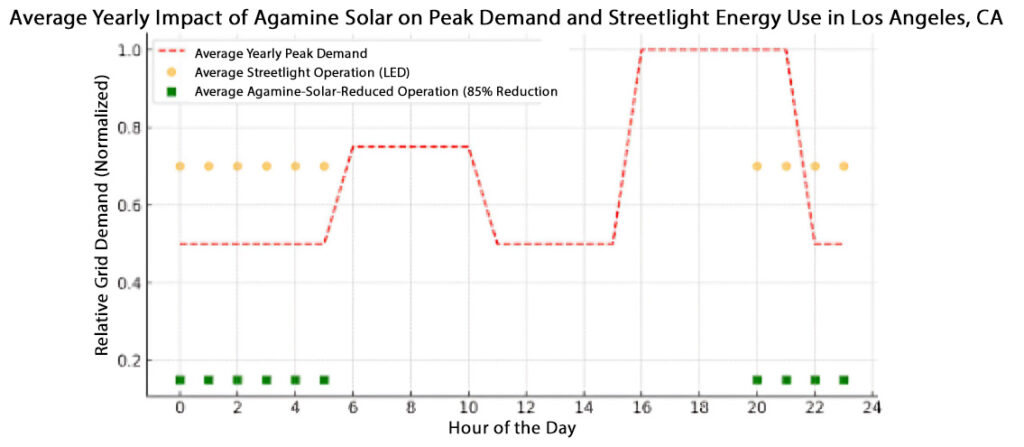Agamine Solar & Grid Resilience: A Smarter Energy Solution for a Large City, USA
Understanding Peak Demand in Los Angeles
Los Angeles municipal energy costs are primarily influenced by peak electricity demand, which follows a predictable pattern based on seasonal climate and usage trends.
Typical Peak Demand Patterns
Summer (June – September)
– Peak Hours: 4 PM – 9 PM (Driven by air conditioning, appliance use, and cooking) Streetlights On: ~8:00 PM – 5:30 AM
Winter (December – February)
– Peak Hours: 6 AM – 10 AM & 4 PM – 9 PM (Driven by heating, lighting, and appliance use) Streetlights On: ~4:30 PM – 7:00 AM

How Agamine Solar Reduces Grid Load & Costs
- Lowering Grid Dependence by 75% – 100%
Most Los Angeles municipalities have switched to energy-efficient ~60W LED streetlights, reducing power consumption compared to older 200W High-Pressure Sodium (HPS) lamps.
- Each Agamine Solar smart streetlight reduces grid electricity usage by 75% to 100% by using solar power and integrated 0.87 kWh energy storage. – At 75% offset: Only 25% of the energy comes from the grid.
- At 100% offset: The pole operates entirely off-grid, eliminating its impact on peak demand.

- Eliminating Peak Overlap
Traditional LED streetlights still activate during evening peak demand, adding stress to the grid and raising municipal electricity costs. Agamine Solar’s stored solar energy eliminates this impact, avoiding peak-time energy charges entirely.
- Demand Response & Utility Incentives
Los Angeles-area utilities, including the Los Angeles Department of Water & Power (LADWP), Southern California Edison (SCE), and Pacific Gas & Electric (PG&E), may offer financial incentives for reducing peak demand.
Agamine Solar: Smart City Ready
Beyond energy savings, Agamine Solar is Smart City Ready, providing municipalities with a future-proof platform for enhanced urban infrastructure. Agamine Solar supports the integration of:

– Streetlight Performance Monitoring: Real-time diagnostics for energy use, outage detection, and maintenance alerts.
– Security Cameras & Detection Systems: Built-in surveillance capabilities improve public safety and assist law enforcement.
– Communication & Connectivity: Agamine Solar poles can be equipped with various wireless technologies, such as 5G small cells, Wi-Fi hotspots, and IoT sensor networks to enhance citywide digital infrastructure.
– Environmental Monitoring: Although currently under development, we are considering air quality, temperature, and gunshot detection sensors that provide valuable urban data and response systems.
By integrating these technologies, cities can leverage Agamine Solar as a foundation for Smart City expansion, modernizing infrastructure while optimizing costs and sustainability.
Streetlights as a Cost Factor in City Budgets
Streetlights account for approximately 40% of municipal electricity costs in most cities, even after transitioning to LEDs.
- A 60W LED streetlight operating 11 hours per night consumes:
o ~660 Wh (0.66 kWh) per day
o ~241 kWh annually per pole - For 1,000 LED streetlights, this equals 241,000 kWh per year.
- Shifting to Agamine Solar reduces this municipal energy burden by 75% to 100%, potentially resulting in near-zero energy expenses.

Utility Incentives Available for Los Angeles Municipalities
1. Self-Generation Incentive Program (SGIP)
- Provides funding for energy storage systems that reduce grid dependency.
- Agamine Solar’s 0.87 kWh battery storage qualifies for $150 – $200 per kWh in rebates.
- For 1,000 Agamine Solar units, a city could receive $130,000 – $175,000 in SGIP incentives.
2. Demand Response Programs (DR)
- Since Agamine Solar doesn’t rely on the grid during peak hours, cities can enroll in demand response programs and receive rebates.
3. Time-of-Use (TOU) Rate Savings
- California utilities charge higher rates during peak hours (4 – 9 PM).
- With Agamine Solar, a city avoids peak-hour costs, significantly lowering annual electricity expenses.
Savings Estimate for 1,000 LED Streetlights:
- Without Agamine Solar: A city pays ~$48,000 annually ($0.20/kWh TOU rate).
- With Agamine Solar at 100% offset, this drops to $0 in energy costs.
- With Agamine Solar at 75% offset, Costs drop to ~$12,000 annually.
4. California Energy Commission (CEC) Grants
The CEC funds energy-efficient public infrastructure projects, and municipalities deploying Agamine Solar may qualify for grants that offset installation costs.
Economic & Sustainability Impact for Los Angeles
✔ Lower municipal energy costs by avoiding peak pricing and demand charges.
✔ Utility rebates covering a portion of the Agamine Solar installation costs.
✔ Enhanced grid stability by reducing evening demand spikes.
✔ Supports sustainability goals, helping Los Angeles meet state carbon footprint reduction mandates.
✔ Smart City Expansion Ready, enabling digital connectivity, surveillance, and real-time data collection.

Final Thought
By integrating Agamine Solar smart streetlights, Los Angeles municipalities can cut electricity costs, secure utility incentives, and modernize city infrastructure—all while easing grid demand, enhancing safety, and preparing for Smart City expansion.

Barry Redman
CEO/Founder NetZero Energy, LLC
Smart Oregon Solutions, VP of Operations
971-506-1006


